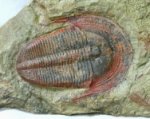Harpetida Trilobites
Order Harpetida was formerly allied with Ptychopariida, until Order Harpitida was erected by Ebach and McNamara in 2002. The subclass Librostoma was created in 1990 by Richard Fortey to cover the orders formally included with the Ptychopariida (i.e., Ptychopariida, Harpetida, Asaphida, and Proetida). The Harpetids are now most often considered to be descendents of Order Ptychopariida, appearing in the upper Cambrian period and going extinct along with many other trilobite orders in the late Devonian period. |
Subclass
Librostoma*
|
||||||||||||||||
|
|||||||||||||||||

 Trilobites
of Order Harpetida are mainly differentiated from others by
a semicircular brim around the front of the cephalon (head).
The brim is often contains small holes that are believed to
have served as a system for filtering food. This brim surrounds
the cephalon extending backward from the front on both sides,
and normally has a prominent suture along the outer edge. Harpetids
typically have small eyes on prominent ridges, twelve or more
thoracic segments, and a small pygidium.
Trilobites
of Order Harpetida are mainly differentiated from others by
a semicircular brim around the front of the cephalon (head).
The brim is often contains small holes that are believed to
have served as a system for filtering food. This brim surrounds
the cephalon extending backward from the front on both sides,
and normally has a prominent suture along the outer edge. Harpetids
typically have small eyes on prominent ridges, twelve or more
thoracic segments, and a small pygidium. 

